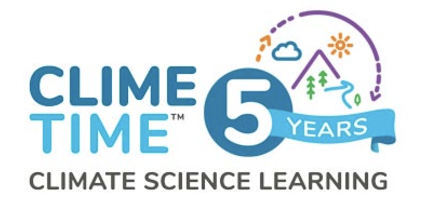Widgetized Section
Go to Admin » Appearance » Widgets » and move Gabfire Widget: Social into that MastheadOverlay zone
ClimeTime: Climate Education in Washington State – Part II
The views expressed are those of the author and do not necessarily reflect the views of ASPA as an organization.
By Tom R. Hulst
December 9, 2024

Part I of the Washington ClimeTime article described the formation of this climate education program in Washington state, guidance on how the work is grounded and examples of different projects. Part II provides outcomes, more examples and next steps throughout the network. The collective work of ClimeTime is greater than the sum of its parts; nonetheless, individual examples highlight the importance of local design and place-based educational initiatives. Contextualizing learning supports the needs of all learners and flourishes within the local environment of a large and diverse state.
ClimeTime After Five Years
In 2023, the impact of ClimeTime was summarized after five years in the 5-Year ClimeTime Report. By then professional learning opportunities had reached approximately 26,000 educators, in 1,847 schools across 200+ school districts, impacting more than 177,200 students. ClimeTime’s success is not determined by mere numbers, however, but in relationships among educational agencies, community-based organizations and Tribal schools.
Students have noticed the improved capacity of educators to engage in climate teaching. One student shared, “This is the only experience I’ve had in school where we talk about actively proposing solutions to the climate crisis and I think that’s important to do on a larger scale.” On the website, over 200+ partner stories highlight student engagement in experiential learning about climate change and application of those lessons to the issues of the local community. Evaluations show ClimeTime stimulates a shift in learning from the classroom to the community, empowering students to address local issues that they care about personally.
Building Capacity for Localization of Climate Learning
Educational leaders need learning opportunities and a community of practice that supports their growth and implementation efforts. The Office of Superintendent of Public Instruction (OSPI) invited the Association of Educational Service Districts (AESD) and the University of Washington to collaborate on overall Network Leadership at the beginning of the program. Key insights provided in the Network Design and Support portrait include leveraging expertise and responsibility, cultivating collaboration within a community of practice and advocating for equitable access to professional learning for educators and science learning for students. Network articles in this resource collection are sorted by different scales of work.
Examples Across the ClimeTime Network
Washington state’s rich diversity is reflected in its mix of cultures and multiplicity of languages. In 2023, over 5,600 students graduated with a Seal of Biliteracy, demonstrating competency in 87 different languages—more than any other state. The OSPI aims to help all multilingual students meet state standards and become fluent in English while valuing their own language and culture. In pursuit of this goal, ClimeTime supports projects that reflect this rich language and cultural diversity as exemplified below:
The Huaka’i (journey): A Winds & Waters Partnerships to Deepen Teachers’ Relationships, Responsibilities, and Stewardship with the Environment. This project partners with Muckleshoot Tribal members and Coast Salish environments, land, and sea to cultivate curiosity and interest.
Voices of Hope Project GLAD Unit. “The Voices of Hope unit provides equitable access to grade-level climate science learning that promotes multilingual development within subject areas. It equips English language learners with the sense of agency necessary to make a positive impact on our planet.
Considering the diverse geographies in Washington, climate learning may appear different in any given place. The following examples of learning opportunities have been designed for specific contexts.
Elementary Students Tackle Air Pollution in their Schoolyards – Silverdale, WA. After teachers joined IslandWood’s “Community-Centered Climate Action” professional learning course, elementary students took on a global problem at a schoolyard scale, investigating school grounds and identifying solutions.
Native Plant Workshops to Restore Local Ecosystems – Oroville, WA. NCESD ClimeTime hosted Learning with Native Plants workshops to support teachers interested in native plants on school grounds with The Guidebook to Starting a School Native Plant Nursery, available as open-source material.
Sustainability Ambassadors, King County, WA. To align climate science, civics and Common Core with the needs of local climate action plans, Sustainability Ambassadors involve students, teachers, community members and green-job workforce leaders in promoting sustainability.
ClimeTime Going Forward
Network participants are observing how climate learning occurs all around us. Diverse knowledge and experiences in every corner of the state foster needed climate action (Yosso 2005; Harvey, et al, 2017) and include the following ideas for further examination:
- Fostering interdisciplinary connections across K-12 learning subjects.
- Exploring leadership structures, including advisory boards, to add community diversity.
- Interweaving networks to foster intergenerational learning, cross-pollination, innovations from experts and mentoring.
- Expanding professional learning and classroom resources to meet the needs of educators and educational leaders across K-12.
- Evaluating the program design and network structures; and sharing results through social media, book clubs and conferences.
- Advocating for funding for sustained climate learning efforts in local systems and more broadly.
ClimeTime integrates climate learning into curricula that foster a deep sense of stewardship. Students learn about environmental justice and the interconnectedness of global ecosystems. Readers of Parts I and II of these articles are invited to implement or expand work in their own context and mobilize efforts across other settings as well. For more information about ClimeTime please visit www.climetime.org and ClimeTime Group Resources|OER Commons.
Authors: Elizabeth Schmitz possesses an MS in Geoscience from Western Kentucky University, and is the Environmental and Sustainability Education Program Supervisor at OSPI; Deb L. Morrison, PhD, is a learning scientist with the Institute for Science and Math Education, University of Washington; Tom R. Hulst received an MA in public administration from Washington State University, and served as policy advisor to Washington Governor Daniel J. Evans.


Follow Us!